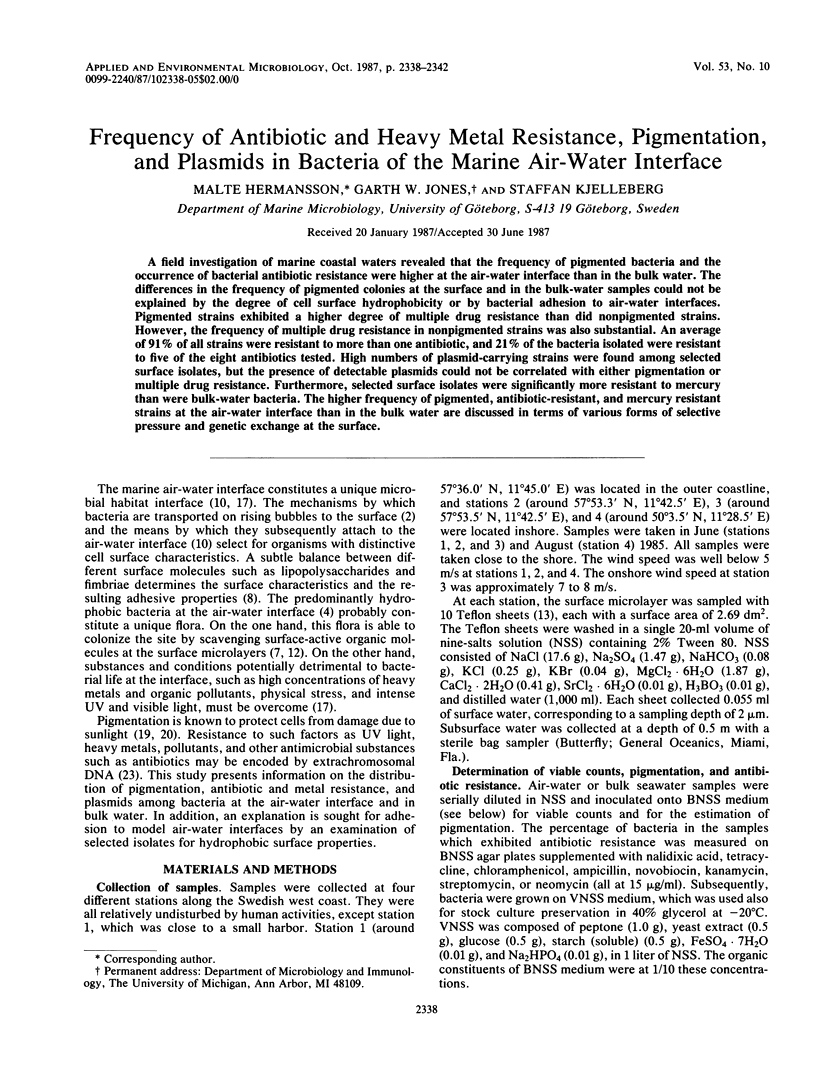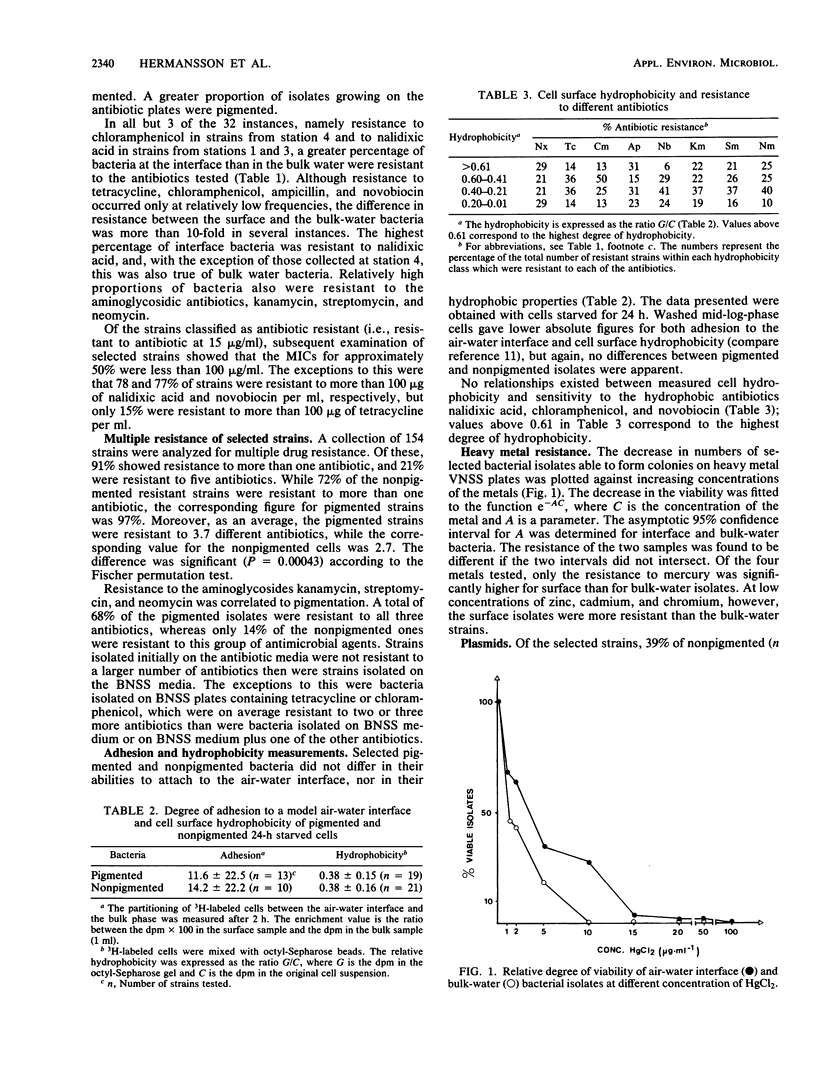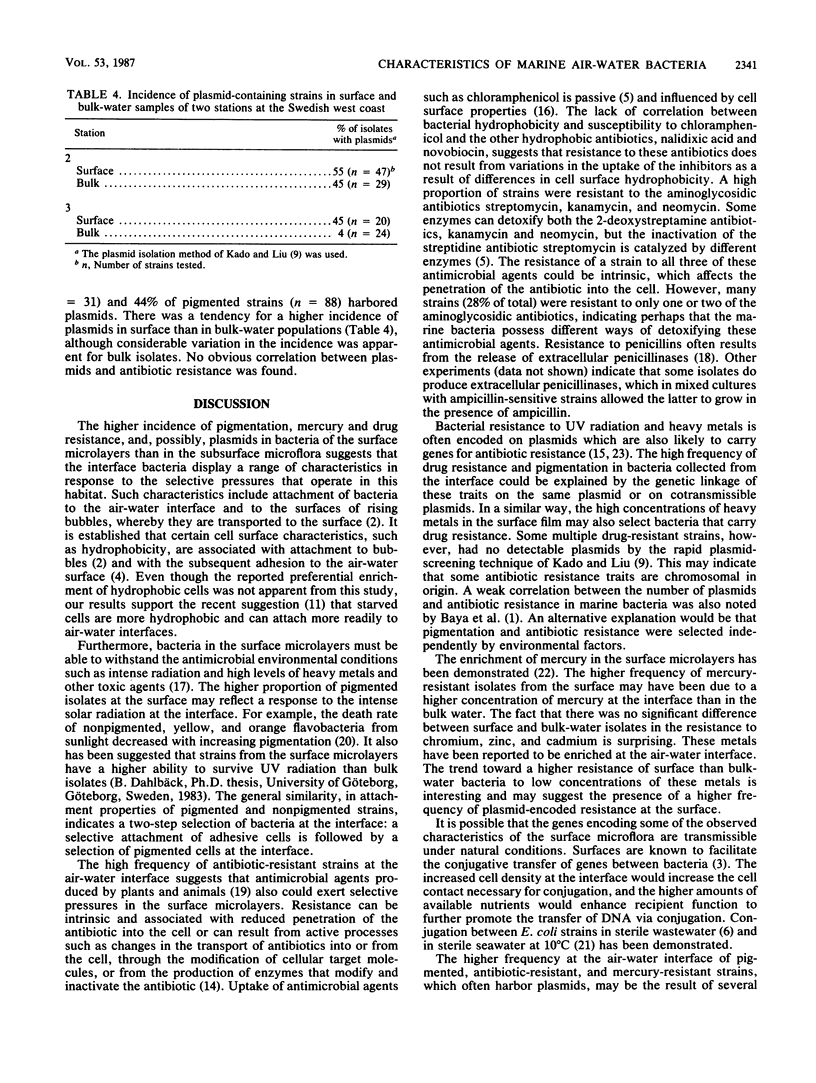Abstract
A field investigation of marine coastal waters revealed that the frequency of pigmented bacteria and the occurrence of bacterial antibiotic resistance were higher at the air-water interface than in the bulk water. The differences in the frequency of pigmented colonies at the surface and in the bulk-water samples could not be explained by the degree of cell surface hydrophobicity or by bacterial adhesion to air-water interfaces. Pigmented strains exhibited a higher degree of multiple drug resistance than did nonpigmented strains. However, the frequency of multiple drug resistance in nonpigmented strains was also substantial. An average of 91% of all strains were resistant to more than one antibiotic, and 21% of the bacteria isolated were resistant to five of the eight antibiotics tested. High numbers of plasmid-carrying strains were found among selected surface isolates, but the presence of detectable plasmids could not be correlated with either pigmentation or multiple drug resistance. Furthermore, selected surface isolates were significantly more resistant to mercury than were bulk-water bacteria. The higher frequency of pigmented, antibiotic-resistant, and mercury resistant strains at the air-water interface than in the bulk water are discussed in terms of various forms of selective pressure and genetic exchange at the surface.
Full text
PDF




Selected References
These references are in PubMed. This may not be the complete list of references from this article.
- Baya A. M., Brayton P. R., Brown V. L., Grimes D. J., Russek-Cohen E., Colwell R. R. Coincident plasmids and antimicrobial resistance in marine bacteria isolated from polluted and unpolluted Atlantic Ocean samples. Appl Environ Microbiol. 1986 Jun;51(6):1285–1292. doi: 10.1128/aem.51.6.1285-1292.1986. [DOI] [PMC free article] [PubMed] [Google Scholar]
- Dahlbäck B., Hermansson M., Kjelleberg S., Norkrans B. The hydrophobicity of bacteria - an important factor in their initial adhesion at the air-water interface. Arch Microbiol. 1981 Jan;128(3):267–270. doi: 10.1007/BF00422527. [DOI] [PubMed] [Google Scholar]
- Foster T. J. Plasmid-determined resistance to antimicrobial drugs and toxic metal ions in bacteria. Microbiol Rev. 1983 Sep;47(3):361–409. doi: 10.1128/mr.47.3.361-409.1983. [DOI] [PMC free article] [PubMed] [Google Scholar]
- Gealt M. A., Chai M. D., Alpert K. B., Boyer J. C. Transfer of plasmids pBR322 and pBR325 in wastewater from laboratory strains of Escherichia coli to bacteria indigenous to the waste disposal system. Appl Environ Microbiol. 1985 Apr;49(4):836–841. doi: 10.1128/aem.49.4.836-841.1985. [DOI] [PMC free article] [PubMed] [Google Scholar]
- Kado C. I., Liu S. T. Rapid procedure for detection and isolation of large and small plasmids. J Bacteriol. 1981 Mar;145(3):1365–1373. doi: 10.1128/jb.145.3.1365-1373.1981. [DOI] [PMC free article] [PubMed] [Google Scholar]
- Kjelleberg S., Hermansson M. Starvation-induced effects on bacterial surface characteristics. Appl Environ Microbiol. 1984 Sep;48(3):497–503. doi: 10.1128/aem.48.3.497-503.1984. [DOI] [PMC free article] [PubMed] [Google Scholar]
- Kjelleberg S., Humphrey B. A., Marshall K. C. Effect of interfaces on small, starved marine bacteria. Appl Environ Microbiol. 1982 May;43(5):1166–1172. doi: 10.1128/aem.43.5.1166-1172.1982. [DOI] [PMC free article] [PubMed] [Google Scholar]
- Koch A. L. Evolution of antibiotic resistance gene function. Microbiol Rev. 1981 Jun;45(2):355–378. doi: 10.1128/mr.45.2.355-378.1981. [DOI] [PMC free article] [PubMed] [Google Scholar]
- Nakahara H., Ishikawa T., Sarai Y., Kondo I., Kozukue H., Silver S. Linkage of mercury, cadmium, and arsenate and drug resistance in clinical isolates of Pseudomonas aeruginosa. Appl Environ Microbiol. 1977 Apr;33(4):975–976. doi: 10.1128/aem.33.4.975-976.1977. [DOI] [PMC free article] [PubMed] [Google Scholar]
- Nikaido H. Outer membrane of Salmonella typhimurium. Transmembrane diffusion of some hydrophobic substances. Biochim Biophys Acta. 1976 Apr 16;433(1):118–132. doi: 10.1016/0005-2736(76)90182-6. [DOI] [PubMed] [Google Scholar]
- Ogawara H. Antibiotic resistance in pathogenic and producing bacteria, with special reference to beta-lactam antibiotics. Microbiol Rev. 1981 Dec;45(4):591–619. doi: 10.1128/mr.45.4.591-619.1981. [DOI] [PMC free article] [PubMed] [Google Scholar]
- Williams P. A. Genetic interactions between mixed microbial populations. Philos Trans R Soc Lond B Biol Sci. 1982 Jun 11;297(1088):631–639. doi: 10.1098/rstb.1982.0066. [DOI] [PubMed] [Google Scholar]


